Protein and Energy Enriched Muffins Designed for Nutritional Needs of Older Adults
Evelina Höglund1*, Berit Albinsson1, Gunnel Stuhr-Olsson2, Michael Signäs3, Christina Karlsson4, Elisabet Rothenberg5 and Karin Wendin1,5,6
1RISE Research Institutes of Sweden, Agrifood and Bioscience, Sweden
2Findus Special Foods, Bjuv, Sweden
3Medirest Compass Group AB, Sweden
4ICA Sverige AB, Sweden
5Food and Meal Science, Kristianstad University, Sweden
6Department of Food Science, University of Copenhagen, Denmark
Submission: February 04, 2017; Published: February 08, 2017
*Corresponding author: Evelina Höglund, RISE Research Institutes of Sweden, Agri food and Bioscience, Box 5401, SE-40229 Göteborg, Sweden, Tel: +46105166619; Fax: +4633135502; Email: evelina.hoglund@sp.se
How to cite this article: Höglund E, Albinsson A, Stuhr-Olsson G, Signäs M, Karlsson C et al. Protein and Energy Enriched Muffins Designed for Nutritional Needs of Older Adults. Nutri Food Sci Int J. 2017; 2(4): 555592. DOI: 10.19080/NFSIJ.2017.02.555592
Abstract
Disease related malnutrition is a common problem among older adults which results in human suffering and high health care costs. One way to counteract this condition is to offer appetizing and nutritious food products adapted to the needs of older adults. However, macronutrient enrichment of food products is not straight forward as it affects flavour and texture properties. In this study, muffins were fortified with rape seed oil and whey powder to reach increased fat and/or protein content and the nutritional value, sensory properties and physical parameters were investigated. The results showed that ingredients could be added to significantly increase the energy and protein density, but enrichment affected on appearance and other sensory properties. Extra fat made the muffins flat and moist with a smooth and fatty mouth feel, while whey powder addition resulted in high/pointy muffins with shiny appearance, hard texture and altered flavours. For co-addition of fat and protein the effects of added protein dominated. The specific role of muffin/cake batter compounds, and their transformation during the baking process, needs to be further investigated. Hence, more research is needed in order to offer older adult appealing foods with high energy and nutrient density.
Keywords: Malnutrition; Older adults; Sensory properties; Nutritional value; Whey protein
Introduction
Due to improved living conditions such as healthcare, nutrition and hygiene the population of older adults is growing worldwide [1]. However, increased nutritional needs regarding protein intake [2,3] together with increased risk of disease and disability make older adults vulnerable for disease related malnutrition (DRM). This is a serious conditions which elevates the risk of weakened immune system, bone and muscle loss, mortality and poor quality of life [4-6], accompanied with a high load on health care costs [7,8]. Reasons for DRM are complex including acute and chronic disease leading to inflammation that in turn causes loss of appetite and muscle wasting. Also, mastication problems and social changes [5] could be involved, as well as impaired appetite due to dry mouth and throat and olfactory dysfunction [9,10]. A poor appetite is strongly associated with poor nutritional intake [11-13].
In order to counteract DRM appetizing and nutritious food products adapted to the nutritional needs of older adults are needed, meaning high energy and nutrient density in small portions. It has been suggested that snacks rich in energy and protein between meals may be a good way to increase overall energy intake [13-15]. Protein-enrichment of regular food products can significantly increase the daily protein intake [16], and it is recommended that protein-enrichment is based on carriers that are already commonly consumed by older adults [17]. However, enrichment levels should not exceed the limit when the characteristics of the food product are altered to a degree which is not accepted by the consumer. In Sweden, coffee time is normally a much appreciated part of the day and muffins is the most popular choice among older adults to complement their cup of coffee (personal communication, Christina Karlsson, nutritional manager, ICA, Sweden, 2014). Hence, designing muffins to suit the nutritional needs of older adults could contribute to decreased DRM.
Muffins and cakes are common bakery products. However, the transformation of the different ingredients during baking is not completely understood. In the oven, the cake sets into a solid foam structure as gas bubbles in the batter expand and coalesce along with starch gelatinization and protein denaturation and aggregation. The foaming properties of the proteins and the degree of starch gelatinization influence the overall rigidity of the foam network. Whey proteins have functional properties such as foaming, gelling and water binding capacity, and have been used to improve bread dough properties [18] and as egg- replacers in muffins and cakes [19-23]. Also, whey protein has a high nutritional value due to its amino acid composition [24,25], and is suggested to have a beneficial effect on muscle protein synthesis in older adults [25]. However, macro nutrient enrichment of food products is not straight forward as the addition of proteins and fat affects flavour as well as texture properties. The aim of this study was to investigate added nutritional value and impact on sensory properties and physical parameters of increased fat and/or protein content in muffins, based on rape seed oil and whey powder addition.
Materials and Methods
Muffin formulation
Four muffin formulations were developed; one standard reference muffin formulation prepared according to the guidelines of the muffin mix producer and three muffin formulations with added nutritional value (extra fat; extra protein; extra fat and protein) (Figure 1, Table 1). The amounts of fat and protein addition were decided by adding as much as possible without exceeding the limit when the characteristics of the resulting muffins were altered too much to be regarded as muffins. In order to regulate the consistency of the batter and keep it similar between muffin formulations, different amounts of water was added (Table 1). The muffins were produced in a pilot scale bakery at RISE Agrifood and Bioscience, Sweden, and the baking procedure was kept as simple as possible to keep the procedure constant. The ingredients were stirred for 3 min and thereafter 20 g batter was added to baking forms. The muffins were baked in a preheated convection oven at 175 °C for 11 min, and thereafter left to cool for 15 min before weight check in triplicate. The muffins were freeze stored (-40 °C) until analysis.
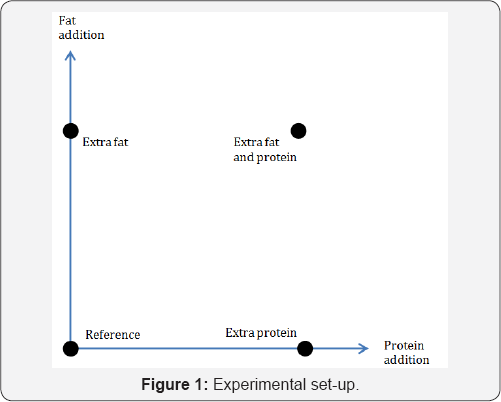
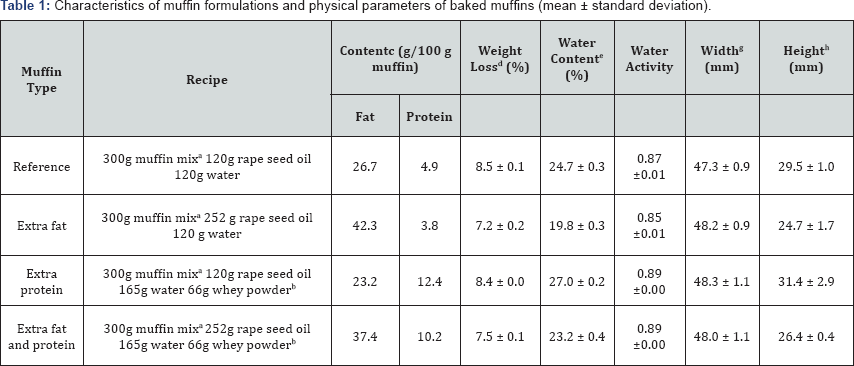
asugar, wheat flour, whole egg powder, potato starch, baking powder E450 an E500, aromas, NaCl, beta-carotene. Mix by B. Engelhardt & Co AB, Sweden.
b76 g protein; 6 g carbohydrates; 10 g fat /100 g powder, B. Engelhardt & Co AB, Sweden.
ccaluculated based on recipe and water loss, dn=5, en=4, fn=2, gn=8, hn=4
Moisture content and water activity
Moisture content was measured gravimetrically in four replicates in a vacuum oven (Sanyo Gallenkamp, Loughborough, UK). Approximately 1.8 g of sample was weighed into an aluminum dish and dried at 80 °C until constant weight achievement. The water activity was measured in triplicates using an Aqua Lab 4TE (Decagon Devices, Pullman, Washington, USA). Mean values and maximum deviations are presented in (Table 1)Width and height were measured by a scale.
Sensory evaluation
Sensory evaluation and training were carried out over a period of 10 days by a trained external panel (SP Food and Bioscience). The panel comprised eight assessors who were selected and trained according to guidelines: ISO 3972, ISO8586-1 and ISO 8586-2. The sensory analysis was made using Quantitative Descriptive Analysis (QDA) [26]. In the test the trained panel developed objective descriptions of perceived sensory attributes products [26]. In two 3-h training sessions, the judges generated set of attributes (Table 2) and developed sensus regarding the evaluation of each attribute. The judges evaluated the perceived intensities on a continuous 100-mm line scale, labeled "low intensity" at 10mm and "high intensity" at 90mm (Visual Analogue Scale). In two sessions (60 min each), the judges were rated triplicates of each product. The intensity ratings were recorded into numbers by a computerized system (FIZZ 2.47 B, Biosystemes, France). The samples were coded with threedigit numbers and presented in randomized order according to a Latin square design. Two muffins were served at the time, together with tap water and neutral wafers. Muffins from the same batch were used for all analyses. The data was statistically analyzed by two-way Analysis of Variance (ANOVA) with samples and assessors as fixed effects. Significance (p≤0.05) between samples was calculated by Tukey's pair wise comparison test (FIZZ 2.47 B, Biosystemes, France).
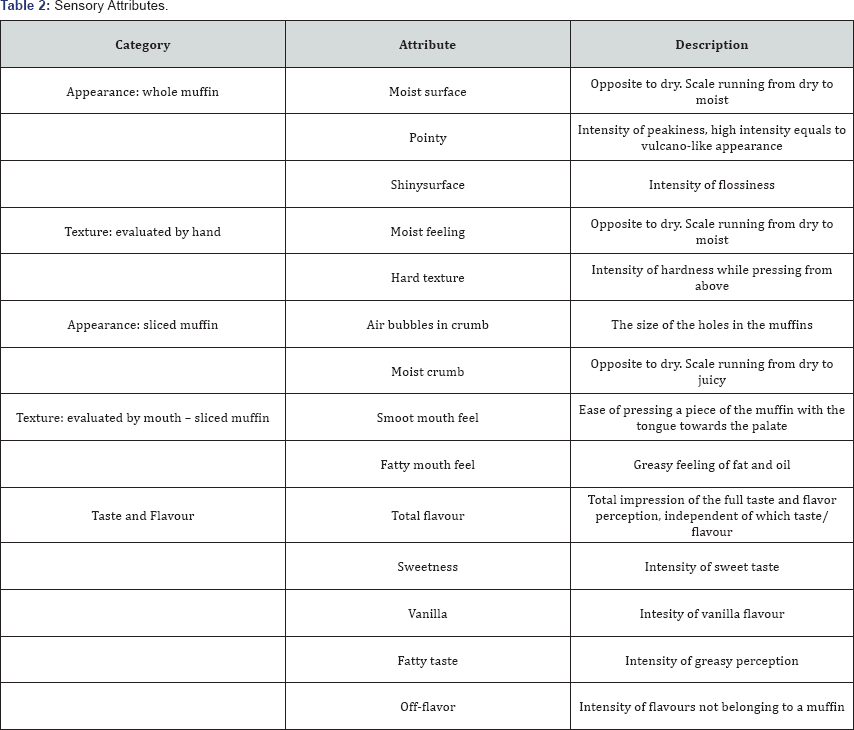
Results
Four muffin recipes were developed; one standard reference muffin recipe and three muffin recipes with added amounts of fat and/or protein; the recipe with added fat resulted in a 60% increase of final muffin fat content; the recipe with added protein resulted in a 153% increase of final muffin protein content; and the recipe with added fat and protein resulted in a 40% increase of final muffin fat content and a 108% increase of final muffin protein content compared to the reference muffin (Table 1). Images of the muffins are presented in Figure 2. Weight loss during baking was expected to be due to loss of water in form of steam. The muffins with added fat had the lowest residual moisture content after baking, but also the lowest weight loss, which could be explained by the lower proportion of water in the batter (Table 1).
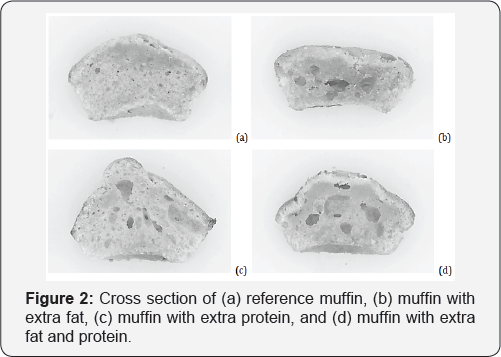
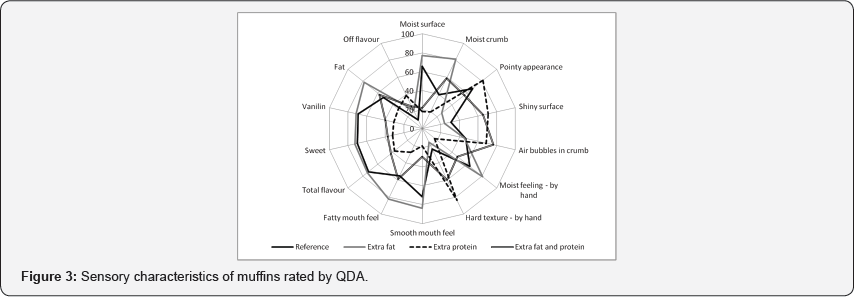
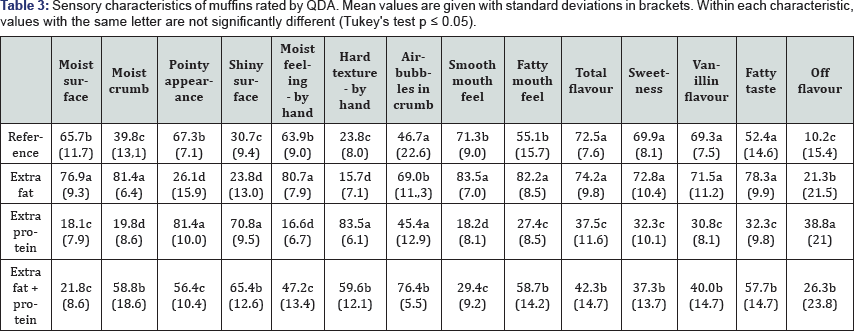
The sensory evaluation generated data over the product properties appearance, texture and flavour (Figure 3, Table 3). Addition of extra fat resulted in flat muffins with a moist surface and crumb and increased fat flavour. Addition of protein, on the other hand, resulted in a pointy muffin which resembled a volcano with smooth batter pouring out from the centre of the muffin top, giving a shiny appearance.
Protein addition also indicated a decrease in total flavour as well as in sweet, vanillin and fat flavour, which may be due to dilution of flavour compounds as whey powder and water was added to the recipe. The panel could detect off flavours described as "eggy", "sharp", "baking soda", or "cottage cheese". These off flavours were perceived to largest extent in the muffins with extra protein and were derived to the whey powder Both sensory and measurement showed that the height increased, described bythe panel as pointy. In the case of co-addition of protein and fat the muffins appearance was quite similar to the formulation with added protein, but without the volcano tip.
Discussions
The effects of the added protein appeared to dominate those of fat addition, both regarding appearance and flavour. Addition of fat and/or protein affected the textural properties of the muffins. The panel evaluated the muffins both by pressing with their fingers and by textural feeling in the mouth. Fat addition resulted in a moist feeling when touched by hand, and a smooth and fatty mouth feel. Protein addition, on the other hand, gave a less moist and smooth muffin with hard texture. The addition of both fat and protein resulted in muffins with textural properties in between that with fat or protein addition, but a bit harder and less smooth than the reference muffin. Hence, whey protein addition made the muffins harder and tougher to chew. This is in line with Paraskevopoulou & Donsouzi [21] who concluded that substitution of egg with whey protein in pound cake resulted in increased hardness and chewiness due to decreased batter aeration and denser crumb structure strengthened by the whey protein particles. The muffins with added whey protein also contained large air bubbles similar to the findings of Yang & Foegeding [27] who reported large air bubbles in angel food cake prepared with whey protein, due to disproportionation and/or coalescence of air bubbles before setting of the foam structure. Native whey protein is compactly folded and soluble in water. Denaturation, on the other hand, results in an unfolded structure with decreased solubility. Hence, the baking properties of whey protein may be improved by pre-treatments that alter the foaming, emulsifying and stabilization properties [28,29]. For example has partial denaturation of whey protein by ultrasound been reported to improve the aerated structure of cake, resulting in higher volume, lower density, and reduced hardness and chewiness [22].
It is important for this study to point out that the recipes with added fat and/or protein were not adjusted for optimized flavour or baking properties. In a commercial application, these factors need to be carefully considered in order to achieve a product accepted by the market. In this study, addition of extra ingredients implied depletion of components in the base recipe such as sugar, flavouring agents and baking powder. The depletion effect was most evident for muffins with protein addition where several flavours were decreased, accompanied by an increase in off flavour. Also, sugar and moisture levels in the batter are important for the starch gelatinization process which affects the resulting volume of cakes [23]. Addition of proteins and fat changed the conditions of starch gelatinization as the proportions of starch, sugar and water is changed which affected muffin volume and texture. In the present study one mixing time and speed was selected for all muffin preparations. However, during development of batter formulations, it was noted that batter mixing time had large impact on the resulting muffin volume. This relationship seemed to be most important for the batter with added whey powder. A long mixing time resulted in a very flat muffin after cooling, due to arching of the muffin bottom. A short mixing time resulted in a very pointy muffin where a large part of the batter poured out from the top and formed a hard and shiny layer. This behaviour was probably connected to the foaming properties of the whey protein, as was also noted by Okkels et al [30]. Evidently, processing conditions are highly important in case of protein addition in order to achieve bakery products of high quality. Whey powder addition involved extra water addition to enable batter mixing and portioning. Even though extra water was added, and the resulting muffin type had the highest moisture content and water activity, these muffins were perceived as dry and though. Similar results were reached by Andersson [31]. The sensorial properties of muffins are affected both by the proportions of macronutrients, but also by parameters such as starch gelatinisation and protein conformation, which in turn depend on processing time and temperature, batter pH, moisture content, water activity, sugar content and more. The specific role of the muffin batter compounds, and their transformation during the baking process, need to be further investigated.
Conclusion
In the present study we have studied the effect of fortifying muffins with energy and proteins. Sufficient amounts of rape seed oil and/or whey powder were added to a muffin batter in order to significantly increase the fat and/or protein content. Offering fortified muffins with nutritional value adapted to the needs of older adults could be one way to counteract DRM. However, the appearance and other sensory properties were affected by the macronutrient addition. Addition of fat made the muffins flat and moist with a smooth and fatty mouth feel. Whey powder addition, on the other hand, resulted in a high and pointy muffin with a shiny appearance, hard texture and low flavour intensity. For co-addition of fat and protein the effect of added protein appeared to dominate the effects of fat addition. The specific role of the muffin batter compounds, and their transformation during the baking process, is not yet fully known, and more research is needed to offer older adult appealing foods with high energy and nutrient density.
Acknowledgements
This study was financed by Tvärlivsprogrammet (Vinnova, Formas, Stiftelsen Lantbruksforskning, Svensk Dagligvaruhandel and Livsmedelsforetagen) and performed in collaboration between SP Technical Research Institute of Sweden/RISE Research Institutes of Sweden, Kristianstad University, Innventia, ICA, Electrolux, Sensinet, Findus, ThermoKing, Medirest, Skane Association of Local Authorities, PRO, NINE, Billerud Korsnas.
Conflict of Interest
No conflict of interest exists.
References
- Fund UNP (2012) Aging in the twenty-first century. UNFPA and Help Age International, USA.
- Bauer J, Biolo G, Cederholm T, Cesari M, Cruz-Jentoft AJ, et al. (2013) Evidence-based recommendations for optimal dietary protein intake in older people: A position paper from the PROT-AGE Study Group. JAMDA 14(8): 542-559.
- Deutz NEP, Bauer JM, Barazzoni R, Biolo G, Boirie Y, et al. (2014) Protein intake and exercise for optimal muscle function with aging: Recommendations from the ESPEN Expert Group. Clin Nutr 33(6): 929-936.
- Liu L, Bopp MM, Roberson PK, Sullivan DH (2002) Under nutrition and risk of mortality in elderly patients within 1 year of hospital discharge. J Gerontol A Biol Sci Med Sci 57A(11): M741-M746.
- Rasheed S, Woods RT (2012) Malnutrition and quality of life in older people: A systematic review and meta-analysis. Ageing Res Rev 12(2): 561-566.
- Stratton RJ, Elia M (2007) A review of reviews: A new look at the evidence for oral nutritional supplements in clinical practice. Clinical Nutrition Supplements 2(1): 5-23.
- Amaral TF, Matos LC, Tavares MM, Subtil A, Martins R, et al. (2007) The economical impact of disease-related malnutrition at hospital admission. Clin Nutr 26(6): 778-784.
- Meijers JMM, Halfens R, JG, Wilson L, Schols jMGA. (2012) Estimating the costs associated with malnutrition in Dutch nursing homes. Clin Nutr 31(1): 65-68.
- Attems J, Walker L, Jellinger KA (2015) Olfaction and aging: A minireview. Gerontology 61(6): 485-490.
- Mobley AS, Rodriguez-Gil DJ, Imamura F, Greer CA (2014) Aging in the olfactory system. Trends in Neuroscience 37(2): 77-84.
- Schlip J, Wijnhoven HAH, H DDJ, Visser M (2011) Early determinants for the development of undernutrition in an older general population: Longitudinal aging study Amsterdam. Br J Nutr 106(5): 708-717.
- Mudge AM, Ross LJ, Young AM, Isenring EA, Banks MD (2011) Helping understand nutritional gaps in the elderly (HUNGER): A prospective study of patient factors associated with inadequate nutritional intake in older medical inpatients. Clin Nutr 30(3): 320-325.
- Van der Meij BS, Wijnhoven HAH, Finlayson GS, Oosten BSH, Visser M (2015) Specific food preferences of older adults with poor appetite. A forced-choise test conducted in various care settings. Appetite 90: 168-1675.
- Shahar D, Shai I, Vardi H, Fraser D (2003) Dietary intake and eating patterns of elderly people in Israel: who is at nutritional risk? European Journal of Clinical Nutrition 57(1): 18-25.
- Nieuwenhuizen WF, Weenen H, Rigby P, Hetherington MM (2010) Older adults and patients in need of nutritional support: Review of current treatment options and factors influencing nutritional intake. Clinical Nutrition 29(2): 160-169.
- Stelten S, Dekker IM, Ronday EM, Thijs A, Boelsma E, et al. (2014) Protein-enriched regular products and their effect on protein intake in acute hospitalized older adults; a randomized controlled trial. Clinical Nutrition 34(3): 409-414.
- Van der Zanden LDT, van Kleef E, Wijk RA, van Trijp HCM (2014) Knowledge, perceptions and preferences of elderly regarding protein- enriched functional food. Appetite 80: 16-22.
- Madenci BA, Bilgicli N (2014) Effect of whey protein concentrate and buttermilk powders on rheological properties of dough and bread quality. Journal of food Quality 37(2): 117-1124.
- Matos ME, Sanz T, Rosell CM. (2014) Establishing the function of proteins on the rheological and quality properties of rice based gluten free muffins. Food Hydrocolloids 35: 150-158.
- Morr CV, Hoffmann W, Buchheim W (2003) Use of applied air pressure to improve the baking properties of whey protein isolates in angel food cakes. LWT 36(1): 83-90.
- Paraskevopoulou A, Donsouzi S, Nikiforidis CV, Kiosseoglou V (2015) Quality characteristics of egg-reduced pound cakes following WPI and emulsifier incorporation. Food Research International 69: 72-79.
- Tan MC, Chin NL, Yusof YA, Taip FS, Abdullah J (2015) Improvement of eggless cake structure using ultrasonically treated whey protein. Food and Bioprocess technology 8(3): 605-614.
- Wilderjans E, Luyts A, Brijs K, Delcour JA (2013) Ingredient functionality in batter type cake making. Trends in Food Science & Technology 30(1): 6-15.
- De Almeida Marques G, de Sao José JFB, Alves Silva D, da Silva EMM (2016) Whey protein as a substitute for wheat in the development on no added sugar cookies. LWT-Food Science and Technology 67: 118126.
- Pennings B, Boirie Y, Senden JMG, Gijsen AP, Kuipers H, et al. (2011) Whey protein stimulates postprandial muscle protein accretion more effectively than do casein and casein hydrolysate in older men. Am J Clin Nutr 93(5): 997-1005.
- Lawless HT, Heymann H (2010) Sensory evaluation of food Series FST, editor New York: USA.
- Yang X, Foegeding EA (2010) Effects of sucrose on egg white protein and whey protein isolate foams: Factors determining properties of wet and dry foams (cakes). Food Hydrocolloids 24(2-3): 227-238.
- Lam RSH, Nickerson MT (2015) The effect of pH and temperature pre-treatments on the physiochemical and emulsifying properties of whey protein isolate. LWT - Food Science and Technology 60(1): 427-434.
- Oboroceanu D, Wang L, Magner E, Auty MAE (2014) Fibrillization of whey proteins improves foaming capacity and foam stability of low protein concentrations. Journal of food Engineering. 121: 102-111.
- Okkels S, Wendin K, Olsson V (2016) Mandelmel-muffins til aldre. Kristianstad, Sweden.
- Andersson M (2015) Protein enriched foods and healthy aging: Effects of almond flour, soy flour and whey protein fortification on muffin characteristics. SP Technical Research Institute of Sweden, Food and Bioscience: 2016: 02.






























